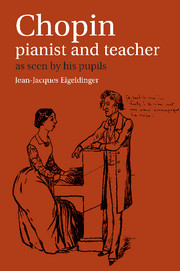Book contents
- Frontmatter
- Contents
- List of illustrations
- Acknowledgements
- Explanation of references
- Editor's note
- Abbreviations
- Introduction
- Part I Technique and style
- Part 2 Interpretation of Chopin's works
- Notes
- List of Chopin's pupils whose recollections are quoted in this book
- Appendix I Translated transcript of Chopin's ‘Sketch for a method’ (Projet de méthode)
- Appendix II Annotated scores belonging to pupils and associates of Chopin
- Appendix III Fingerings and annotations in the scores of pupils and associates
- Appendix IV Chopin's playing described by his contemporaries
- Bibliography
- Index of persons
- Index of musical works
Part I - Technique and style
Published online by Cambridge University Press: 05 June 2014
- Frontmatter
- Contents
- List of illustrations
- Acknowledgements
- Explanation of references
- Editor's note
- Abbreviations
- Introduction
- Part I Technique and style
- Part 2 Interpretation of Chopin's works
- Notes
- List of Chopin's pupils whose recollections are quoted in this book
- Appendix I Translated transcript of Chopin's ‘Sketch for a method’ (Projet de méthode)
- Appendix II Annotated scores belonging to pupils and associates of Chopin
- Appendix III Fingerings and annotations in the scores of pupils and associates
- Appendix IV Chopin's playing described by his contemporaries
- Bibliography
- Index of persons
- Index of musical works
Summary
BASIC TECHNIQUE
Time is still the best critic, and patience the best teacher.
ChopinDefinition of pianistic technique
Intonation being the tuner's task, the piano is free of one of the greatest difficulties encountered in the study of an instrument. One needs only to study a certain positioning of the hand in relation to the keys to obtain with ease the most beautiful quality of sound, to know how to play long notes and short notes, and [to attain] unlimited dexterity.
Chopin, PMMistakes in customary approaches to ‘pure’ technique
To those who are studying the art of playing the piano I suggest some practical and simple ideas which I know from experience to be really useful. As art is infinite within the limits of its means, so its teaching should be governed by the same limits in order to give it boundless potential […] So we are not dealing with more or less ingenious theories, but with whatever goes straight to the point and smoothes the technical side of the art […] People have tried out all kinds of methods of learning to play the piano, methods that are tedious and useless and have nothing to do with the study of this instrument. It's like learning, for example, to walk on one's hands in order to go for a stroll. Eventually one is no longer able to walk properly on one's feet, and not very well on one's hands either.
- Type
- Chapter
- Information
- Chopin: Pianist and TeacherAs Seen by his Pupils, pp. 23 - 64Publisher: Cambridge University PressPrint publication year: 1987



